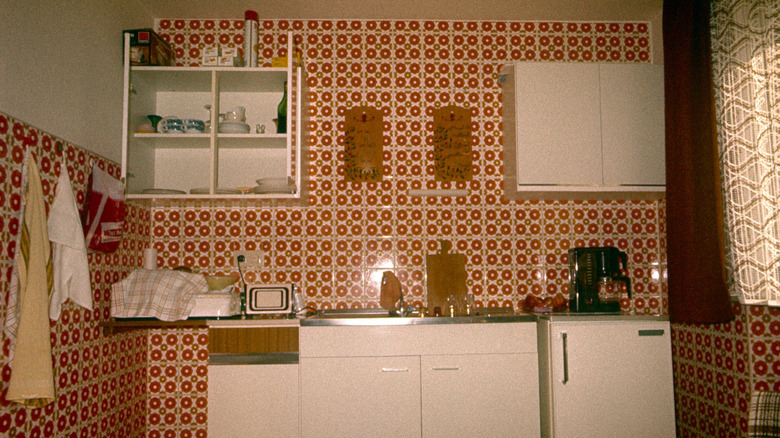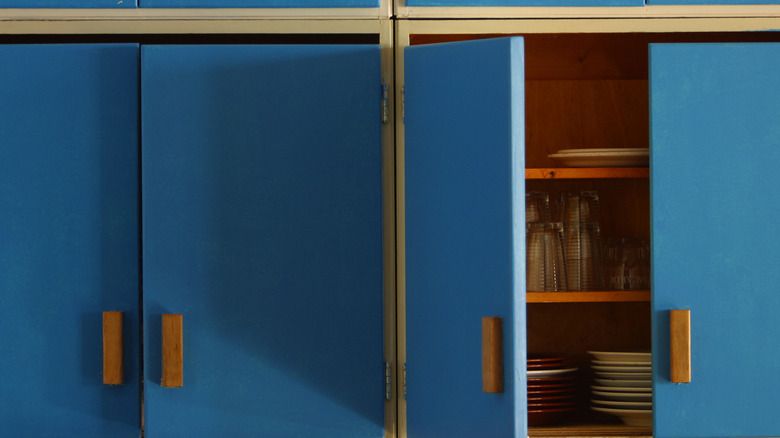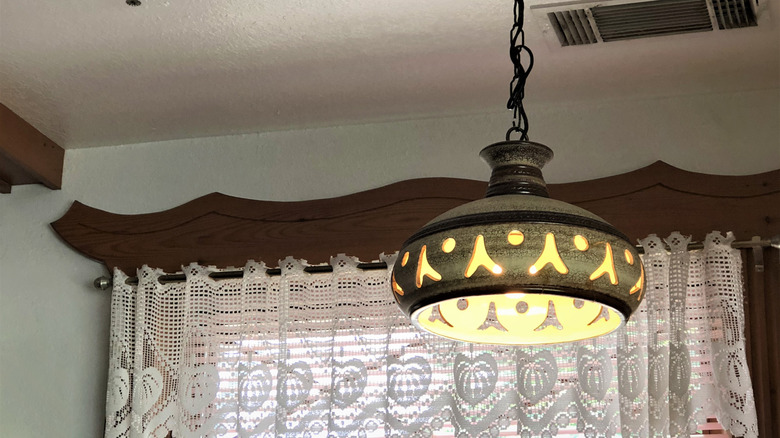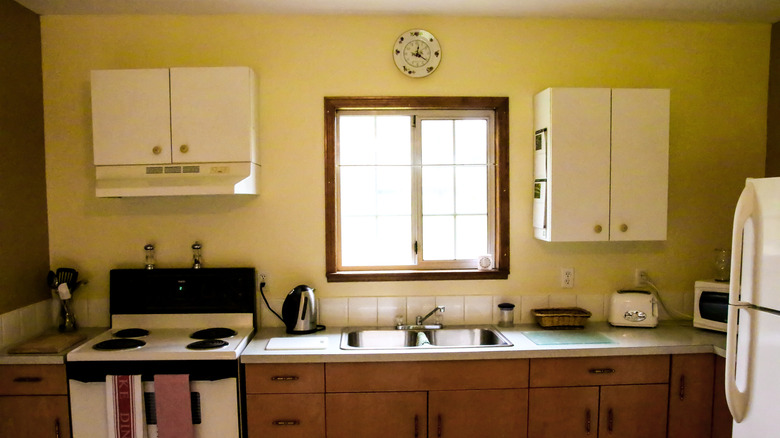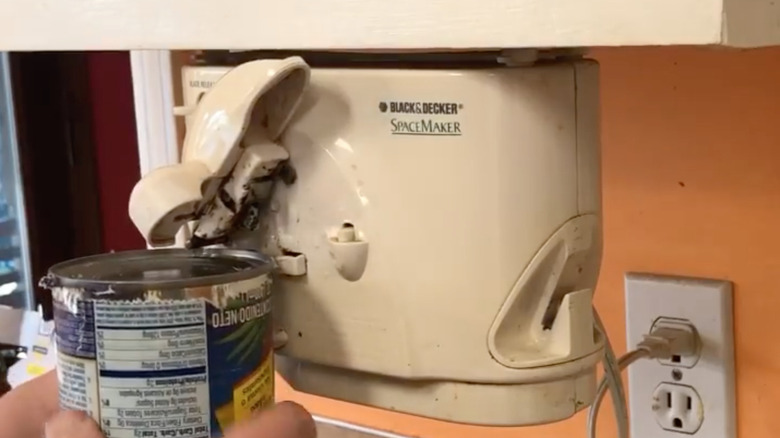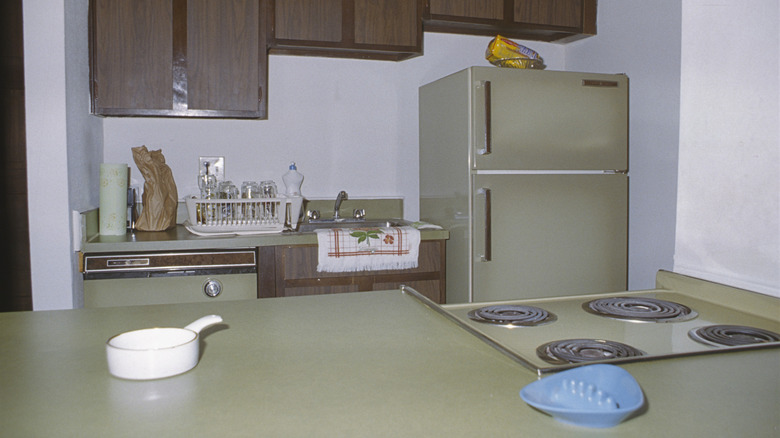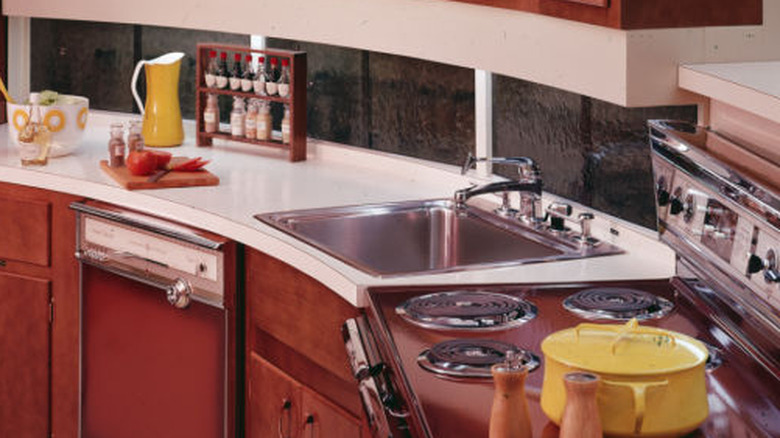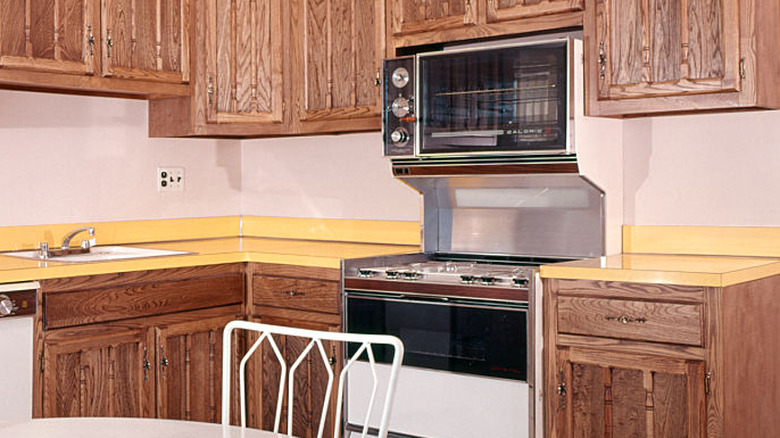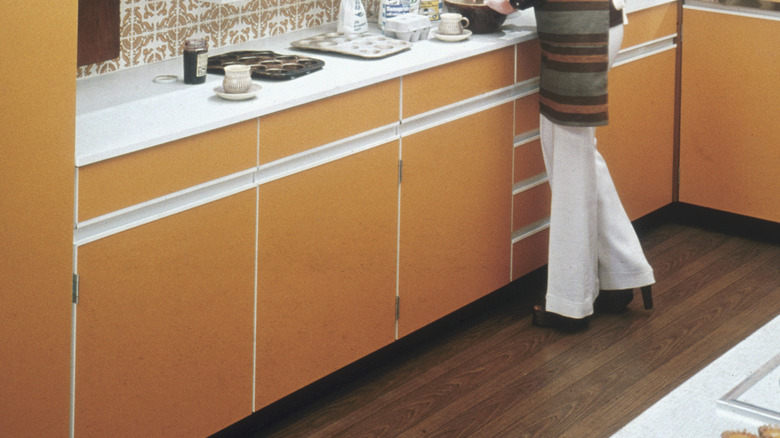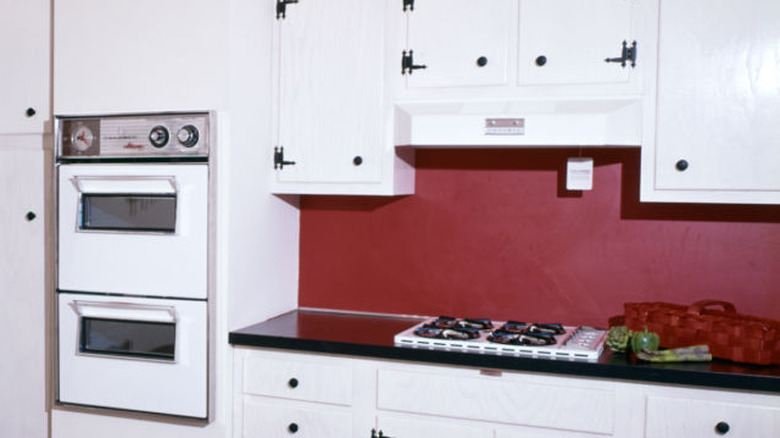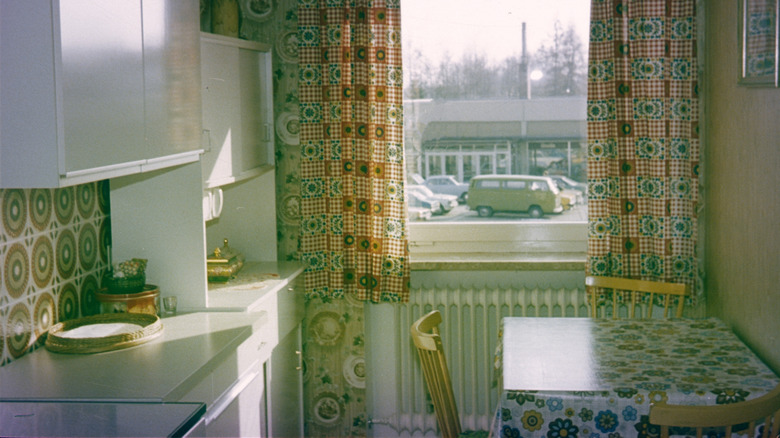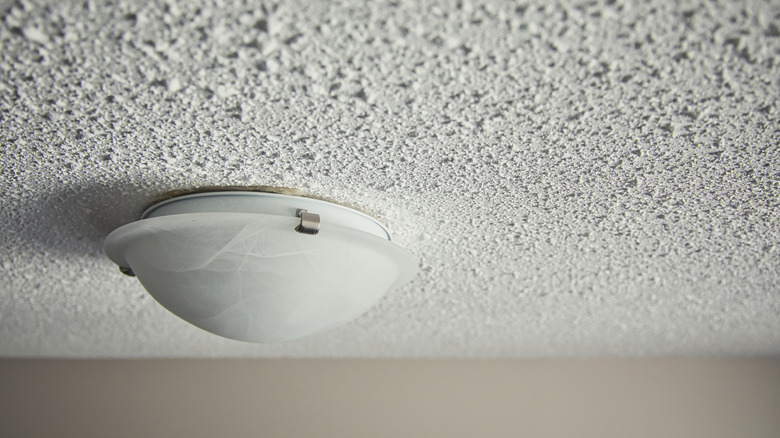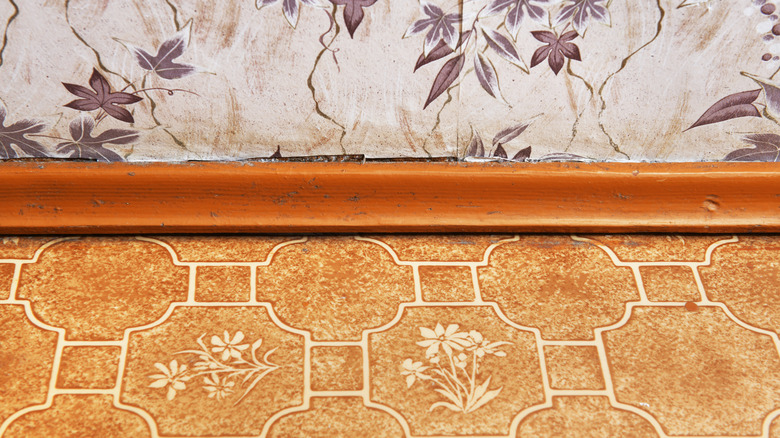15 Must-Do Swaps To Update A '70s Kitchen Eyesore
We may receive a commission on purchases made from links.
If your home features a 1970s-era kitchen, chances are at least a few elements would have been better left in that decade. In recent years, designers have revived some nostalgic kitchen décor from the '60s and '70s that instantly brings back all the good vibes: patterned wallpaper, latch-hook rugs, bread boxes, and amber glassware, among others. Of course, there are also plenty of the era's trends that haven't experienced a resurgence and feel old or outdated as a result. From Formica countertops to buttery paint colors and a lack of natural light, these features can make your kitchen look undeniably retro — and not in a good way.
If you want to modernize your dated kitchen, you don't have to rip everything out and start from scratch. A lot of the '70s features can be easily replaced with their contemporary counterparts. Details such as cabinet hardware and light fixtures simply require finding an alternative that's more suited to your current style preferences. Swapping out these tacky or ill-fitting features is a great way to quickly make your space more attractive and functional. Some aspects of an original 1970s kitchen, such as the lack of natural light and a closed-off floor plan, might require more time and money to bring up to date. So, how many of these changes would benefit your '70s kitchen?
Upgrade dated hardware
The hardware in your kitchen can have a huge impact on its overall aesthetic. Swapping out your drawer pulls and handles is an easy way to update your space without the need for a huge renovation. Many 1970s kitchens featured hardware made from painted ceramic or then-trending bold styles such as Lucite. These bright or neon colors can feel out of place in the sleek or earthy designs of many modern kitchens. Instead, why not bring your kitchen into this decade with some shiny, tasteful brass handles that go great with nearly every 2025 color of the year?
Get rid of yellow-toned light fixtures
The 1970s saw natural colors like yellow rise in popularity. It was a palette that dominated everything from fashion to furniture and kitchens. Many '70s-era light fixtures give off a yellowish glow, which can make a modern kitchen feel like it's yellowing with age rather than with style. (That's especially true if they're still fitted with incandescent rather than LED bulbs.) For a more cohesive, up-to-date look, swap these dated fixtures for something sleeker. Choose a color that matches the rest of your kitchen to take advantage of modern color drenching trends and use a cool-toned lightbulb.
Paint the butter yellow walls
The demand for earth-toned colors in the 1970s didn't just stop with accessories and fixtures. Kitchens, living rooms, and even bedrooms were painted in these shades because of a widespread interest in nature. While some of these colors remain popular, many of them — like harvest or butter yellow — are stuck firmly in the past. You can still opt for natural shades in your kitchen, but if you'd like to give the room a modern update, paint over that yellow with dusky blue or terracotta red. These colors feel grounded and work with modern trends like cottagecore.
Replace any outdated appliances
Small details can have an outsized impact on interior design. While changing all those little things may sound overwhelming, it can help bring your dated '70s kitchen into the modern day. Switching out portable appliances that you don't use will instantly refresh your space. Try replacing that old, probably rusty mid-century electric can opener with something that modern homeowners are more likely to use and find more practical for food preparation. An air fryer or vacuum sealer — like this Mzrot 6-in-1 Food Vacuum Sealer — comes to mind.
Cover large appliances in drab colors
Replacing outdated appliances is a quick way to modernize your kitchen — and that doesn't have to mean buying new. In the 1970s, large appliances like dishwashers and fridges typically came in drab shades of yellow, green, or cherry red with black details. To transform your kitchen into a modern marvel, replace these big appliances with modern, elegant stainless steel versions. Alternatively, for a more budget-friendly option, cover the existing appliance with a Livelynine Brushed Nickel Peel-and-Stick Vinyl Wrap. It will give a fridge, for example, the appearance of metal without that new appliance price tag.
Replace the small steel corner sink
An often-overlooked element of kitchen design is the sink. You might not consider that a stainless steel 1970s kitchen sink a problem. After all, the material is easy to clean, durable, and still trending today. However, when it's one of the tiny, impractical corner sinks so popular in the era or the sink is paired with dated Formica or laminate countertops, the overall effect is outdated at best and grungy at worst. If you don't want to redo your countertops, replacing the sink with something modern, like a white farmhouse sink, will elevate your kitchen design quickly.
Switch out the countertops
If you are up for completing a bigger kitchen renovation, changing out tired countertops can totally transform the room from '70s relic to contemporary wonder. Because countertops take up so much space in a kitchen, peeling laminate and outdated colors like avocado green or mustard yellow can negatively affect the overall design. Why not try out some stylish butcher block for your next kitchen remodel? They're an up-to-date and long-lasting countertop material.
Let in more natural light
Many 1970s kitchens are known for having an oppressive feel due to a lack of natural light and the use of dark materials like brown oak. One pricey way to update the room and give it a more contemporary feel is to add more windows or a skylight. This will let in more sunlight. If a kitchen renovation on this scale isn't feasible, switch to a lighter wall color. Whiter hues reflect the sunlight around the room rather than absorbing it, helping you make the most of existing natural light.
Paint or repanel the range hood
Much like other functional items like the kitchen sink, the range hood — the device above your stovetop that filters out smoke and grease — is often overlooked. However, many range hoods in 1970s kitchens were crafted from silver stainless steel or dark brown-painted metal, making them an unsightly, outdated blight on your kitchen design. Paint or repanel your range hood so that it matches your cabinets or walls, integrating it into your modern kitchen for a fraction of the price of a new appliance.
Add fluting and trim to flat cabinets
Both 1970s and 1980s kitchens featured cabinets with a flat profile. The handles were either flush with the surface or set within the cabinet door. While this may seem modern, the boxy shapes and straight lines tend to resemble cheap, machine-made cabinetry. Instead, hop on the recent craze for cabinets with decorative trim and molding. It adds bespoke texture and visual interest to your kitchen. You could even try fluted molding for an ultra-trendy take.
Replace the bulky upper cabinets with open shelving
If your '70s-era kitchen feels oppressive, it's probably because of all the upper cabinets. Opt to remove them. This trend is increasingly popular for 1970s kitchen remodels because it's an easy way to open up the space. It's the ideal swap because of its flexibility. Still need storage but don't want bulky cabinets? Replace them with open shelving. Don't have much to store? Hang wall art or install a sleek backsplash where the upper cabinets once were. Bonus: Use the remodel as downsizing and decluttering inspiration.
Use large tiles or wallpaper in place of a garish backsplash
An original 1970s backsplash can suck the life out of your kitchen, particularly if it features the floral-patterned tiles so popular during that period. To infuse the room with a modern, trendy feeling, swap in large, earthy-hued, patternless tiles. These organic touches make your kitchen feel warm and inviting — far more than the busy, obviously mass-manufactured tiles ever did. Alternatively, remove the old tiles and cover the space with sage green check wallpaper for an understated yet trendy look.
Open up your cramped '70s kitchen
Some 1970s kitchens were designed around the idea that only one member of the family — namely the wife or mother — would be in there cooking and cleaning. As a result, kitchens were often small and separated from the rest of the house by walls and doors. Today, these activities are more communal, and as such, contemporary homeowners prefer open-plan layouts. If you have enough in your home renovation budget, refresh your cramped 1970s kitchen by knocking down any non-load-bearing walls or replacing solid kitchen doors with glass-paneled French doors.
Cover a popcorn ceiling with wood planks
If you have a 1970s kitchen, it may have a popcorn ceiling. Popcorn ceilings haven't been popular for a long time due to their retro feel and tendency to stain easily. Worse, some of these ceilings contain asbestos. Replacing them isn't just a matter of fashion but also important for your health. You can, of course, scrape it away — once asbestos testing is completed. Or, for a safe and affordable way to disguise this unsightly feature, cover your popcorn ceiling with wooden planks. They add warmth and character to your kitchen.
Replace lifting Linoleum flooring
Though this is quite the feat, changing the outdated 1970s flooring in your kitchen is an absolute must if you want to make the space modern, practical, and aesthetically pleasing. Linoleum flooring was hugely popular in the 1970s, and it was often used in the kitchen because it was easy to clean. However, this material has a tendency to warp, discolor, or fade over the years. Swap it out for a more reliable, contemporary flooring material. Large ceramic floor tiles are a great alternative; they're luxurious, timeless, and durable.
